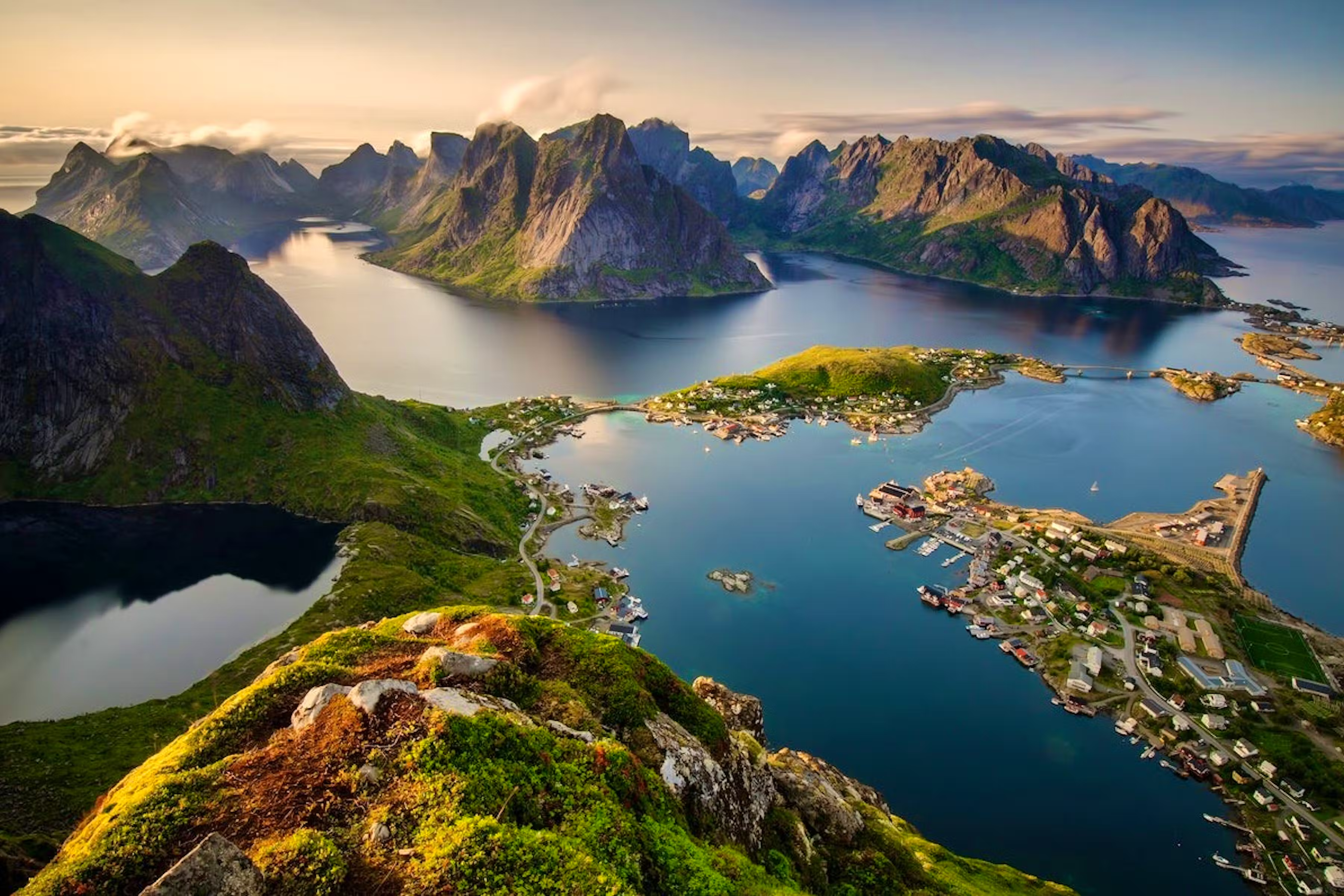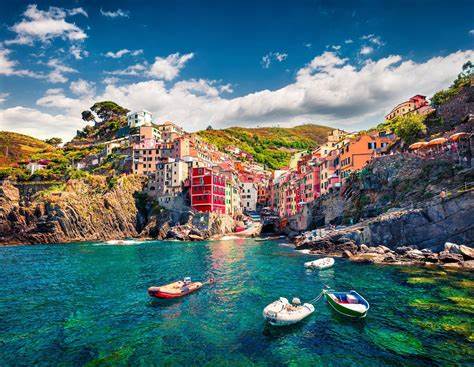The Lofoten Islands, located above the Arctic Circle in Norway, are often regarded as one of the most beautiful and untouched places in the world. With jagged mountains, crystal-clear waters, and picturesque fishing villages, Lofoten offers an idyllic retreat for those looking to explore dramatic landscapes and experience the Arctic in its rawest form. Whether you’re an outdoor enthusiast, a photographer, or simply someone in search of tranquility, the Lofoten Islands are the perfect destination.
Best Time to Visit Lofoten Islands
The Lofoten Islands are stunning year-round, but the best time to visit depends on the kind of experience you’re looking for:
- Summer (June to August): Experience the Midnight Sun, where the sun never fully sets. This is the perfect time for outdoor activities like hiking, kayaking, and cycling. The weather is mild, and the landscapes are lush and green.
- Autumn (September to November): A quieter time to visit with fewer tourists. You can witness the northern lights while enjoying the golden hues of autumn.
- Winter (December to February): For those seeking a magical Arctic winter experience, this is when the northern lights are most visible. Winter activities like dog sledding and snowshoeing are popular during this time.
- Spring (March to May): As the snow begins to melt, you’ll see a blend of lingering winter landscapes with the first signs of spring, making it perfect for photography.
How to Get There
Lofoten is accessible by plane, ferry, and car. The most common way to reach the islands is by flying into Leknes Airport or Svolvær Airport, which have connections to Oslo and Bodø. You can also take a ferry from Bodø to Moskenes, which offers beautiful views of the surrounding coastline. If you enjoy road trips, driving the E10 highway, which connects the islands, is a scenic route that offers incredible views at every turn.
Top Attractions in Lofoten Islands
- Reine
- One of the most photographed villages in Norway, Reine offers stunning views of towering peaks and crystal-clear waters. The picturesque red and white fishing cabins (rorbuer) dot the coastline, creating a serene atmosphere. You can hike the Reinebringen mountain for breathtaking panoramic views of the village and surrounding fjords.
- Henningsvær
- Known as the “Venice of Lofoten,” Henningsvær is a small fishing village built on several small islands connected by bridges. The charming village features a small harbor, unique art galleries, and scenic views of the Lofoten peaks. It’s a great place to experience local culture and enjoy fresh seafood.
- Lofoten Beaches
- The islands are home to some of the most beautiful beaches in Norway. Haukland Beach and Uttakleiv Beach are famous for their white sand and turquoise waters, offering a surreal contrast to the towering mountains. Although the water may be too cold for swimming, these beaches are perfect for photography and picnics.
- Kvalvika Beach and Ryten Mountain Hike
- Kvalvika Beach is a remote, hidden gem only accessible by foot, making it perfect for hikers seeking peace and isolation. The hike to Ryten Mountain offers incredible views of the beach below and surrounding peaks. It’s an unforgettable hike for those looking for both beauty and tranquility.
- Northern Lights and Midnight Sun
- Lofoten is one of the best places to experience the Northern Lights in winter, and during summer, you can witness the mesmerizing Midnight Sun, where the sun stays above the horizon all night long. Whether you visit in winter or summer, the natural light displays are spectacular and offer unforgettable experiences.
Things to Do in Lofoten Islands
- Hiking
- Lofoten is a hiker’s paradise with countless trails offering panoramic views of the islands. Popular hikes include The Reinebringen for a stunning aerial view of Reine, Vareid Beach, and The Offerfjell Trail, which takes you to one of the island’s highest peaks. Be sure to pack proper footwear, as trails can be rocky and uneven.
- Kayaking and Fishing
- The calm, clear waters surrounding the islands make for excellent kayaking opportunities. Paddle between fjords, past dramatic cliffs, and through small coves. Lofoten is also known for its fishing culture, so you can try your hand at fishing or join a guided fishing trip to catch cod and other local fish.
- Wildlife Watching
- The Lofoten Islands are home to diverse wildlife. Spot seabirds, including puffins, eagles, and cormorants, or visit the Lofoten Aquarium in Kabelvåg to learn about marine life. In the winter, you might even spot whales migrating along the coast.
- Photography
- Lofoten is a photographer’s dream. The landscapes here—ranging from towering mountains and fjords to quaint fishing villages and stunning beaches—offer ample opportunities to capture stunning shots. Early morning and late evening provide the best lighting for photography, especially with the northern lights or sunset.
- Experience Local Culture
- Lofoten’s local culture is rooted in its fishing heritage. Visit the Lofoten Museum and Viking Museum in Borg to learn about the history and traditions of the islands. You can also experience traditional food like stockfish (dried cod) or fresh seafood dishes in local restaurants.
What to Eat
The food in Lofoten is heavily influenced by the surrounding sea. Seafood lovers will be in paradise, with fresh fish and shellfish available in abundance. Here are a few dishes to try:
- Stockfish: Dried cod, a staple of the Lofoten diet, often served in soups or as part of traditional dishes.
- Reindeer: The Lofoten Islands are home to reindeer herding, and you’ll find reindeer meat featured in local dishes.
- Lofoten Fish Soup: A creamy and hearty soup made with local fish, vegetables, and cream.
- Fresh Arctic Cod: Best enjoyed grilled, baked, or in a traditional fish stew.
Travel Tips
- Pack for the Weather: The weather in Lofoten can be unpredictable, so it’s essential to bring warm, waterproof clothing, especially if you plan to hike or engage in outdoor activities.
- Local Transportation: Renting a car is the most convenient way to explore the islands at your own pace, especially if you want to visit remote spots. Alternatively, local buses and ferries are available.
- Respect Nature: The islands are an eco-sensitive area. Be sure to follow Leave No Trace principles and stay on designated trails to protect the environment.
Why Visit Lofoten Islands?
The Lofoten Islands offer some of the most spectacular natural beauty in the world, with a unique combination of rugged mountains, pristine beaches, and vibrant culture. Whether you’re hiking, kayaking, fishing, or simply relaxing in one of the charming villages, Lofoten offers a perfect escape for those looking to experience the Arctic in its purest form.
If you’re looking for a destination that feels like a hidden gem, where nature and culture blend seamlessly, the Lofoten Islands are calling your name.





